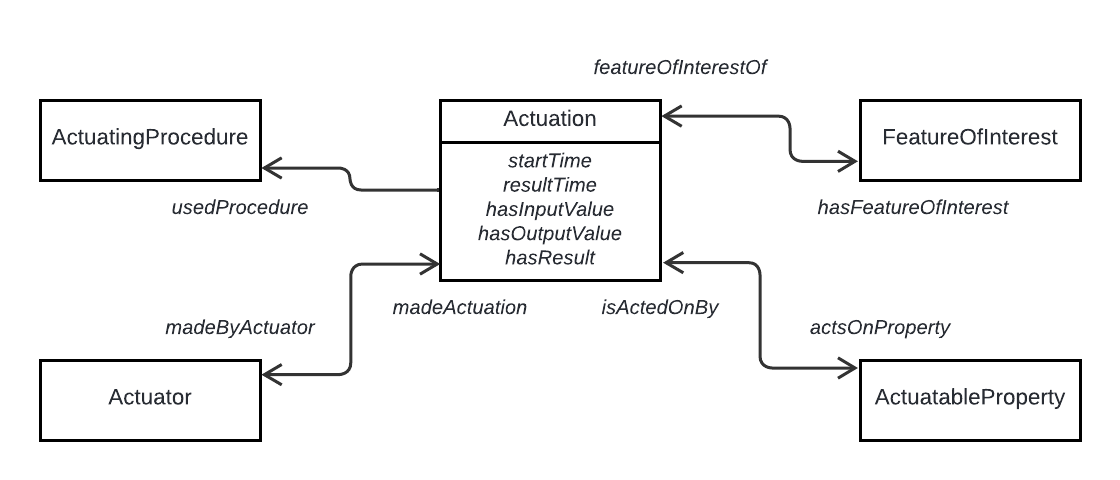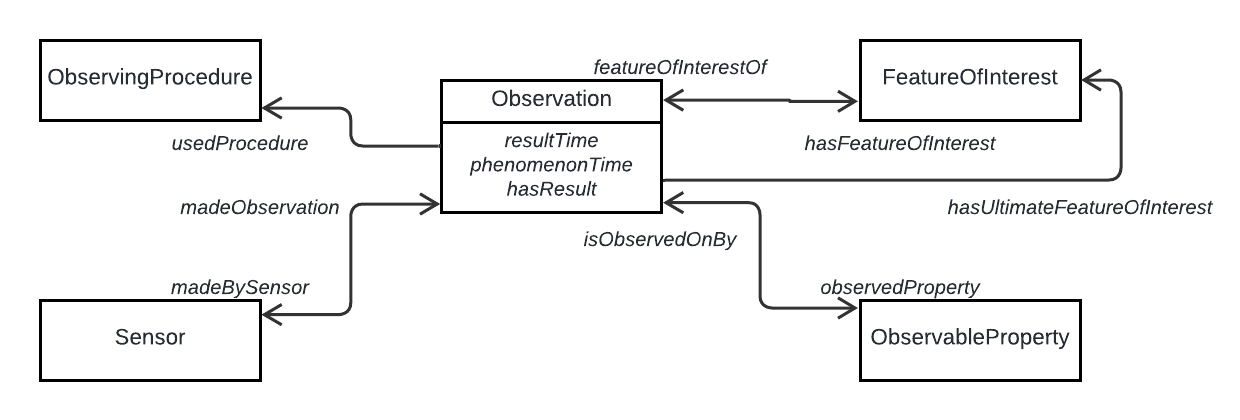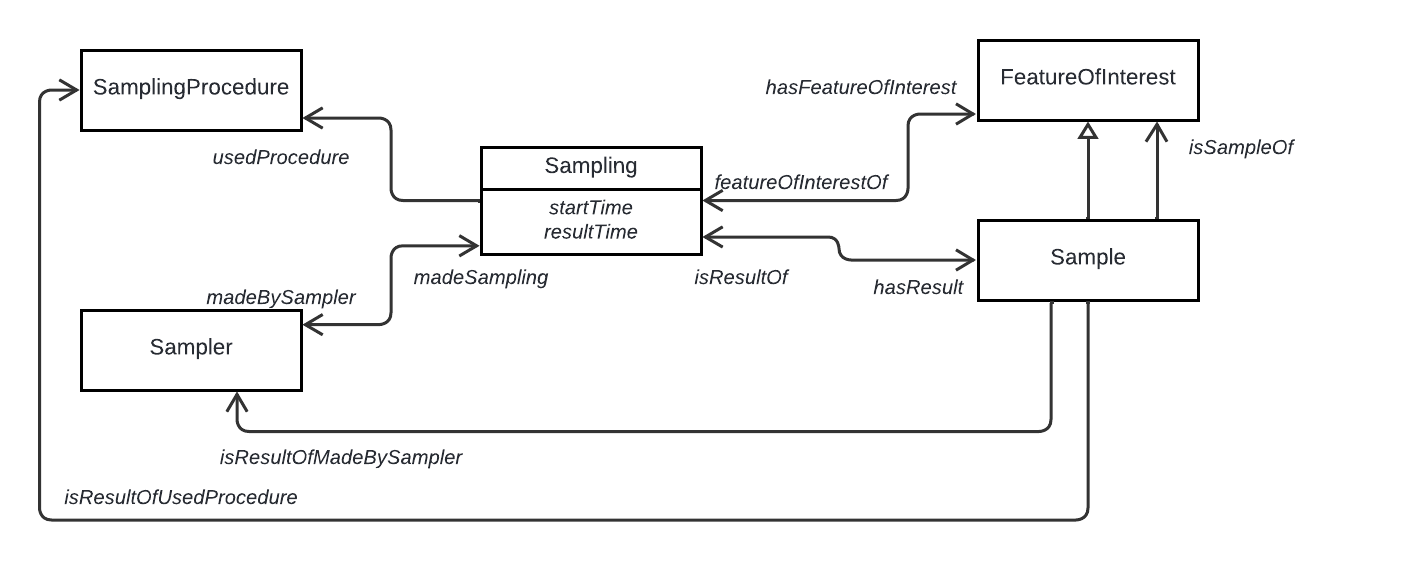Specification
This section introduces the specifications for the RDF implementation of the Semantic Sensor Network Ontology.
RDF implementation
Namespaces
The namespace for the core terms is http://www.w3.org/ns/sosa/
The suggested prefix for the SOSA namespace is sosa:.
Dependencies
Each module of the SSN Ontology is packaged as an RDF file.
The RDF representations use owl:imports statements to implement the dependencies.
Within each graph, where further information (axioms and annotations) is added to an existing term,
rdfs:isDefinedBy indicates the module where the term was originally defined.
Expressivity
The SOSA modules contains the basic definitions of the core terms with minimal axiomatization - only
rdf:type and owl:inverseOf - together with key annotations rdfs:label ,
skos:definition , schema:domainIncludes , schema:rangeIncludes, plus
other annotations as required.
The SSN modules contains the full axiomatization of the core terms, importing SOSA modules and using
rdfs:subClassOf, rdfs:subPropertyOf, owl:Restriction with the various
associated RDFS and OWL structures.
Distribution
SOSA
SOSA Common is available at http://www.w3.org/ns/sosa/common/.
SOSA Actuation is available at http://www.w3.org/ns/sosa/act/.
SOSA Observation is available at http://www.w3.org/ns/sosa/obs/.
SOSA Sampling is available at http://www.w3.org/ns/sosa/sam/.
The complete SOSA is available at http://www.w3.org/ns/sosa/.
SSN
SSN Common is available at http://www.w3.org/ns/ssn/common/.
SSN Actuation is available at http://www.w3.org/ns/ssn/act/.
SSN Observation is available at http://www.w3.org/ns/ssn/obs/.
SSN Sampling is available at http://www.w3.org/ns/ssn/sam/.
The complete SSN is available at http://www.w3.org/ns/ssn/.
Overview of Classes and Properties
The following figures show the key classes and properties in the ontology modules, from the perspectives of Actuation, Observation, and Sampling.

Explanation of the notation used in class diagrams.

Explanation of the notation used in class diagrams.

Explanation of the notation used in class diagrams.
The following are alphabetical lists of the classes and properties in the SSN Ontology.
Classes: sosa:ActuatableProperty , sosa:Actuation , sosa:ActuatingProcedure , sosa:ActuationCollection , sosa:Actuator , sosa:Deployment , sosa:FeatureOfInterest , sosa:MaterialSample , sosa:ObservableProperty , sosa:Observation , sosa:ObservationCollection , sosa:ObservingProcedure , sosa:Platform , sosa:Procedure , sosa:Property , sosa:PropertyOfInterest , sosa:Sample , sosa:SampleCollection , sosa:Sampler , sosa:Sampling , sosa:SamplingProcedure , sosa:Sensor , sosa:SpatialSample , sosa:StatisticalSample , sosa:Stimulus , sosa:System
Object Properties: sosa:actsOnProperty , sosa:deployedOnPlatform , sosa:deployedSystem , sosa:detects , sosa:forProperty , sosa:hasDeployment , sosa:hasFeatureOfInterest , sosa:hasInput , sosa:hasInputValue , sosa:hasMember , sosa:hasOriginalSample , sosa:hasOutput , sosa:hasOutputValue , sosa:hasProperty , sosa:hasResult , sosa:hasSample , sosa:hasSampledFeature , sosa:hasSubSystem , sosa:hasUltimateFeatureOfInterest , sosa:hosts , sosa:implementedBy , sosa:implements , sosa:inDeployment , sosa:isActedOnBy , sosa:isFeatureOfInterestOf , sosa:isHostedBy , sosa:isObservedBy , sosa:isPropertyOf , sosa:isProxyFor , sosa:isResultOf , sosa:isResultOfMadeBySampler , sosa:isResultOfUsedProcedure , sosa:isSampleOf , sosa:madeActuation , sosa:madeByActuator , sosa:madeBySampler , sosa:madeBySensor , sosa:madeObservation , sosa:madeSampling , sosa:observedProperty , sosa:observes , sosa:phenomenonTime , sosa:relatedObservation , sosa:resultQuality , sosa:usedProcedure , sosa:wasOriginatedBy
Datatype Properties: sosa:hasSimpleResult , sosa:resultTime , sosa:startTime
The SSN classes and properties are described in the following sections, organized by module as described in Modularization above.